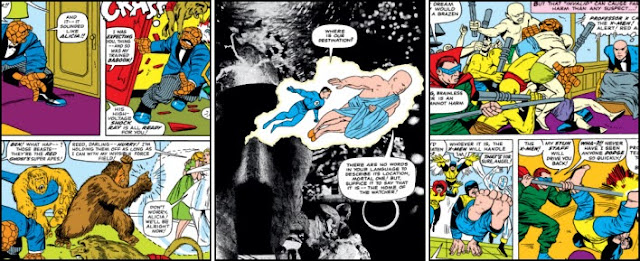 |
| FANTASTIC FOUR ANNUAL No. 3, October 1965 |
Admittedly, the basic premise behind this comic’s narrative is undeniably contrived with Doctor Doom “skilfully manipulating my high-frequency emotion charger” so as to “fan the flames of hatred in the heart of every evil menace in existence” and resultantly create “a veritable army of the most deadly villains alive” with which to destroy Reed Richards’ famous quartet. Yet the utter simplicity of the ‘hokey’ plot point does allow for the reader to be rapidly immersed in the mad machinations of the “paranoiac” Puppet Master, and no sooner has his poison-armed pawn been subdued by Nick Fury’s undercover agents, than Ivan Kragoff and Harvey Rupert Elder make their separate moves to bring Su Storm’s imminent wedding ceremony to a deadly end; “Ahh! The coast is clear now, my beauties! And so, the time has come for the Red Ghost and his Super Apes to finish the job they’d begun many months ago!” This rapid succession of threats and foes is so successfully implemented that any thoughts as to the dubiously manufactured nature of the script is swiftly forgotten and replaced with a genuine sense of awe at Lee’s sheer vision, with even Attuma, “merciless warlord of the deep”, deciding to seize the moment and threaten the land-dwellers with an invasion of his trident-carrying legions.
Of course, just how enjoyable this carousel of costumed crime-fighters and malevolent Machiavellian evil-doers would be without the dynamically-charged pencilling of Jack “King” Kirby is hotly debatable. The Manhattan-born artist’s breath-taking visuals for this comic provides every punch, kick and energy blast portrayed with just the sort of bone-crunching energy one would expect from an illustrator “widely regarded as one of the medium’s major innovators.” Whilst his incredible splash-page “photo of a journey thru the Fourth Dimension” which depicts the Watcher transporting Mister Fantastic to “a laboratory whose wonders beggar description” was certainly worth the twenty five cent cover price of this book alone.
 |
| Written by: Stan Lee, Drawn by: Jack Kirby, and Inked by: Vince Colletta |








































